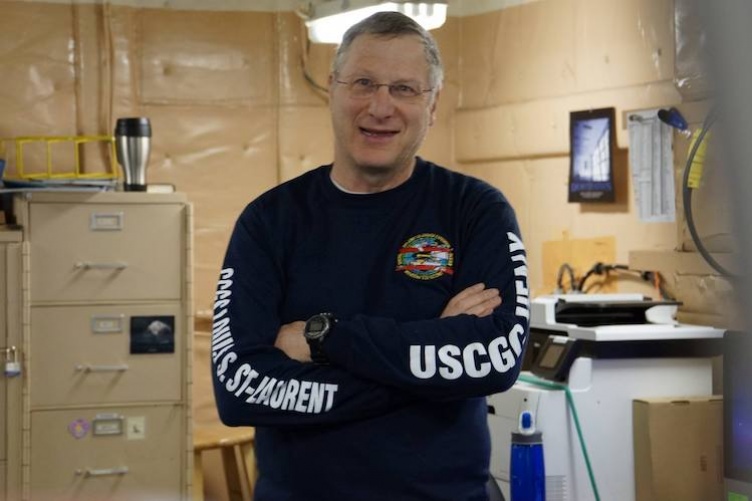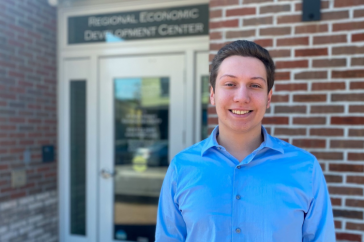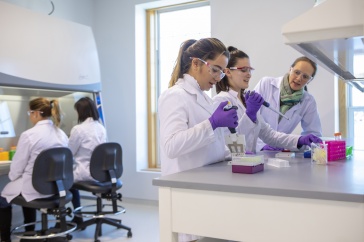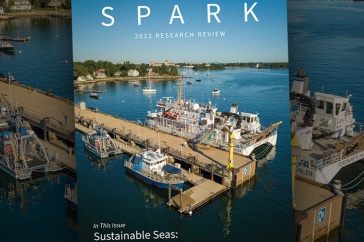
Editor's Note: This is the latest installment in our ongoing series featuring UNH faculty sharing their stories in their own words.
Larry Mayer, director, Center for Coastal And Ocean Mapping
“I grew up in the Bronx. My grandfather owned a small laundry in Manhattan, next to a sporting goods store. I remember that it had scuba equipment and I was enthralled with it. When I was 7, my grandfather bought me the book, “The Boy Beneath the Sea” by Arthur C. Clarke. It was about a young boy who had an aqua lung. Then he bought me a mask and snorkel — I had not yet been to the beach — and I used it in the bathtub. That was it for me; I wanted to be an oceanographer from then on.
Maybe it was a mistake to decide that early, but it made me focus. In junior high school I did a term project all about oceanography. From whence I came, parents wanted their kids to go to med school. I was fortunate to have parents who did not ask me to do that and allowed me to pursue my dreams.
I was the first in my family to go to or graduate from university. I was followed by my sister and brother. After the kids all graduated, my mother got a high-school equivalency diploma, then a bachelor's and then a master's degree.
When it was time to think about college, I wanted to go to the top three schools for oceanography: Scripps, Woods Hole, Lamont. Then, there was the second tier: Washington, Miami, Hawaii, Rhode Island. I applied to them all. I heard back from the top three and they said I couldn’t apply there because they were graduate schools. I was so naïve.
During the summers throughout high school, I worked at a hotel in the Catskills to make the money that was going to pay my college tuition. But I knew I could be replaced any minute. So when I got a letter from the University of Rhode Island telling me to pick a weekend to come for summer orientation, I was nervous because I didn’t want to lose my job. But I got up the courage to ask the maître d for the time off, and he said OK but only for one particularly slow weekend.
Then I heard back from the university that that weekend was full, so I called them. They said it wasn’t completely full, just for biology majors, which I had chosen thinking that was the way to become an oceanographer. I said that I didn’t care what my major was as long as it would lead to oceanography. They said they didn’t have many geology majors and there was room for them that weekend. So that’s how I became a geology major — I had never had a course in geology before.
It was very fortuitous. I ended up going to Rhode Island as a geology major and got involved in research with a professor who was doing underwater landslide modeling. When it came time to go to graduate school, my undergraduate advisor didn’t want me to go to my top three choices; he wanted me to apply to Stanford where he had gone. Instead I went to Scripps (Scripps Institution of Oceanography). I drove a Datsun 1200 from Rhode Island to La Jolla, California and found a house to share in Del Mar where many rich and famous people lived (Jimmy Durante, Lucille Ball, Dese Arnez, i.e.) during the summer race season. We could live there year-round because it wasn’t a great house. I went right into a Ph.D. program.
I could have stayed at Scripps after I graduated but I really missed New England. I love snow and the seasons changing. Plus, I met my wife, Sue, in Del Mar. We knew we didn’t want to get married in California, so I decided to do my postdoc at the School of Oceanography at the University of Rhode Island.
It was 1979. We were supposed to get married that August. Two weeks after we moved back I got a call from the director of the Deep-Sea Drilling Program in California asking if I could come to Curacao in a few weeks. A special mini leg trip through the Panama Canal that I was supposed to be part of in December had to be moved up to August.
I said I had just gotten to Rhode Island and hadn't started anything yet, so the timing was great and that the only thing I had scheduled was getting married Aug. 19. He said I should go home and tell Sue that Dave Moore called with an opportunity that was really exciting, and that if she was going to marry an oceanographer this sort of thing was going to happen all the time so she should take this opportunity to really think about whether she wanted to marry an oceanographer. I went home and repeated it word-for-word to Sue. It made sense to her so we postponed the wedding, and I went to sea not knowing if I would be getting married until I got home. She still agreed, and we are about to celebrate our 40th anniversary. I have been on several deep-sea drilling legs since, with each leg about two months long. I’m approaching 80 months at sea.
When I’d been in California, I had a roommate whose father was friends with the administrator at NASA. They were looking for oceanographers to become a new type of scientist-astronaut. I applied for what I thought was a payload specialist — that is, a scientist who goes on one mission. After a year of selection and background checks, I was selected as a finalist for the first class of mission specialists who were going to be full-time astronaut scientists. I didn’t know what type of position I had applied for until I got to Houston.
Someone else was selected. I never thought I wanted to be an astronaut, but after coming so close it made me wish I had made it.
After I finished my postdoc, I became an assistant professor of oceanography at Dalhousie University in Nova Scotia. I was there from 1982 to 1991, teaching and doing research. From there I went to the University of New Brunswick and became the Industrial Research Chair in Ocean Mapping. In 2000, I found out that UNH wanted to start an ocean mapping program. That’s when I came here."
Mayer is one of the world's leading experts in seafloor mapping. Read about his research at UNH's Center for Coastal & Ocean Mapping/Joint Hydrographic Center.
-
Written By:
Jody Record ’95 | Communications and Public Affairs | jody.record@unh.edu



















































